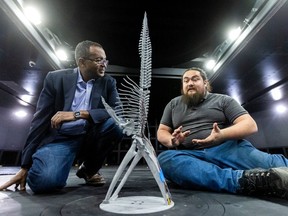Whale of a job: Western's wind tunnel puts unique sculpture to the test
A model of what will be a massive sculpture of a blue whale skeleton by a Canadian photographer and artist is being tested at Western University’s wind dome.

Article content
A model of what will be a massive sculpture of a blue whale skeleton by a Canadian photographer and artist is being tested at Western University’s wind dome.
The Standing Whale, conceptualized by Edward Burtynsky, is envisioned as a life-sized sculpture, part of Burtynsky’s portrayal of the impact of human industry on the planet.
Based on the recovered skeletons of North Atlantic blue whales that died off the coast of Newfoundland in 2014, the piece is Burtynsky’s first large-scale work, and will stand 23 metres (75 feet) tall, according to a release.
The engineering process – a partnership between Queen’s University and Western – of building a sculpture that withstands winds of any speed is supervised by project manager David Didur, who mediates the artistic intention and engineering challenges.
“The structural concept needed engineering input and understanding,” Didur, of Think2Thing Inc., said.
Western’s wind engineering, energy and environment dome (WindEEE) in southeast London has 100 fans that can recreate severe storm systems, allowing operators to study the impact of high wind. It can simulate tornadoes, downbursts and gusts and is used to understand the potential impact of storms on buildings, structures, wind turbines, forests and crops.
One solution for stability would be guidewires, but esthetically, it doesn’t work for the piece, Didur said.
Working alongside the engineering teams at both universities and testing a scale model at Western’s wind dome, Didur said they have begun to understand where the stresses and pressures are on the sculpture.
Following the test results on the stainless steel model, engineers will be able to see what’s required to reinforce the sculpture to ensure no risk of collapsing.
The planned sculpture doesn’t have a home yet, but it will be outdoors, Didur said.
“As we subject the scale to the wind speed, we’re measuring what kind of wind speed produces what kind of force for this ship (scale model),” said Girma Bitsuamlak, a professor in wind engineering at Western.
Takeo Herzag-Hara, a Queen’s graduate student, built the $10,000 scale model, which, at 1/25 the size of the planned sculpture, is 0.9 metres (three feet).

“The design process took a while” to come up with parts that would provide usable data on wind strain, said Herzog-Hara. “We had a stainless steel 3D printing company print the pieces.”
Herzog-Hara said assembly took nearly 10 hours.
Bitsuamlak predicted the life-sized sculpture could cost millions of dollars to build.
“I’ve built many things in my life but I’m a man that tries to understand both (the artist’s and the engineer’s) sides,” Didur said. “In the past, it was always difficult. The artist couldn’t communicate with the engineer because they just spoke a different language. And that’s changed with the computational tools they have. So that allows artists and architects and designers to basically put (forward) something really innovative and challenging.”








Postmedia is committed to maintaining a lively but civil forum for discussion. Please keep comments relevant and respectful. Comments may take up to an hour to appear on the site. You will receive an email if there is a reply to your comment, an update to a thread you follow or if a user you follow comments. Visit our Community Guidelines for more information.